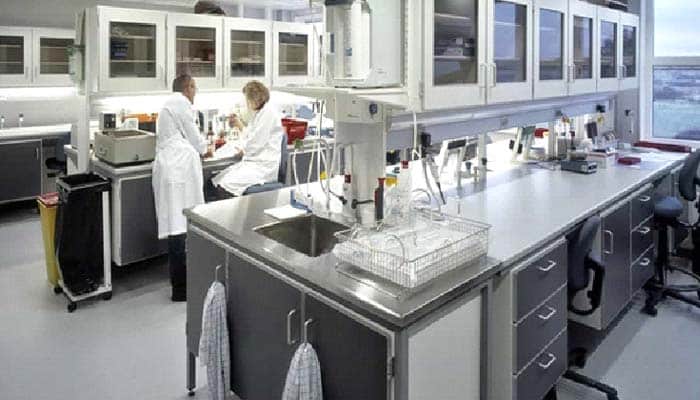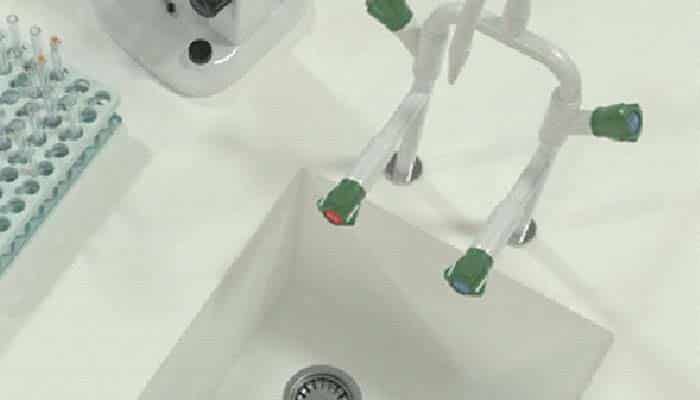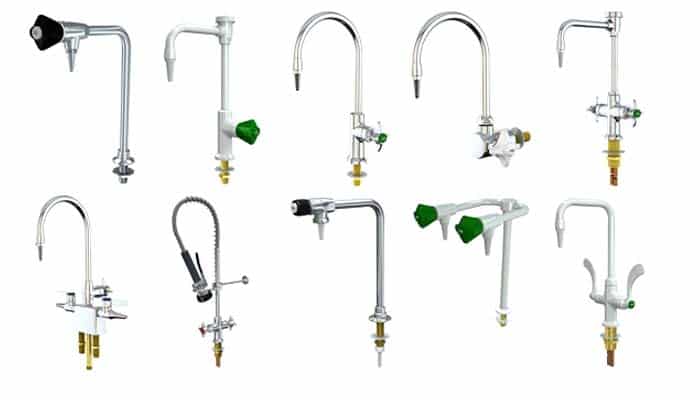Laboratory Sink and Faucet Buying Guide

The most important step in the construction of all laboratories is the initial needs assessment and their prioritization. Therefore, according to the objectives that the laboratory will follow, the size of the laboratory and the number of people who work in the laboratory daily, the necessary plans are made and then implemented. Laboratory scaffolding determines the appropriate work space and placement of equipment, devices, documents, materials and samples. Scaffolding a laboratory does not only mean installing all kinds of cabinets, closets and desks, but also includes things such as the use of suitable coverings for the floor and walls, suitable electrical wiring for the laboratory, water and gas piping, sewage and toxic wastes. And contaminated, installing all kinds of laboratory sinks and valves, emergency showers and eye washes, and air conditioning systems.
If you’re setting up a laboratory, one of the most important features you’ll need is a laboratory sink and faucet. But with so many options available, it can be challenging to know where to start. Here is a buying guide to help you choose the right sink and faucet for your laboratory needs.
So, here are the main questions; what are the differences between regular sinks and faucets and how you can choose the best for your lab? We are going to answer these questions in the following article.
Laboratory sinks
The laboratory sink is one of the main components of the facilities and scaffolding of all laboratories. According to the application that the buyer intends, they can be sold with anti-acid, ceramic, stainless steel and polypropylene. Also, laboratory sinks are made in suitable sizes on the washing cabinet, under the shelf and under the chemistry hood.
Different types of laboratory sinks
The most common types of laboratory sinks are drop-in and under-mount sinks. Drop-in sinks, as the name suggests, drop into the countertop from above. Under-mount sinks are installed from below and secured to the countertop. Under-mount sinks are easier to clean and maintain as they have no rim to trap dirt and debris. In order to buy online all kinds of laboratory sinks you could visit https://royaniran.com/.

Common materials for making laboratory sinks
Laboratory sinks are made from various materials, including stainless steel, epoxy resin, and porcelain. Stainless steel is the most popular choice for laboratory sinks as it is durable, easy to clean, and resistant to corrosion. Epoxy resin is a synthetic material that is resistant to chemicals, heat, and impact. Porcelain sinks are less common, but they are durable and resistant to chemicals.
Laboratory faucets
There are several types of faucets available for laboratory sinks, including manual, sensor-activated, foot pedal, and combination faucets. Manual faucets are operated by turning them on and off with a handle. Sensor-activated faucets are hands-free, and they operate when an object (such as a hand) is detected by the sensor. Foot pedal faucets are foot-operated, and they are beneficial for labs where hands-free operation is critical. Combination faucets offer a combination of manual, sensor, and foot pedal options.

Maintenance guide for laboratory sinks and faucets
Considering the maintenance requirements of your sink and faucet is very important. Stainless steel sinks are easy to clean and maintain, while epoxy resin sinks require special cleaning agents to prevent damage. Sensor-activated faucets require regular battery replacements, while manual faucets may need periodic replacement of washers and O-rings.
How science lab sinks are different than ordinary household sinks?
The main difference between laboratory sinks and faucets and ordinary household sinks and faucets is that laboratory sinks and faucets are designed to meet the specific needs of scientific experimentation, while ordinary household sinks and faucets are designed for everyday use. So, it is important to use appropriate sinks and faucets in the laboratory to ensure the safety of the lab workers and to maintain laboratory equipment.
Here are some of the key differences:
Laboratory sinks are typically made of materials that are resistant to chemicals, heat and impact, such as stainless steel, epoxy resin, or porcelain. This is important to prevent damage to the sink and to ensure that chemicals do not leach into the environment. Household sinks, on the other hand, are often made of materials such as ceramic or cast iron, which are not designed to withstand harsh chemicals or high temperatures.
Laboratory sinks are often larger than typical household sinks, as they are designed to accommodate larger laboratory equipment and to allow for the efficient cleaning of lab equipment and hazardous materials. Household sinks, on the other hand, are usually smaller and designed for everyday use.
Laboratory faucets are often designed to be hands-free, foot-pedal operated, or sensor-activated, to prevent the contamination of samples or equipment during experiments. They may also have special features, such as eyewash stations or emergency showerheads, to ensure the safety of lab workers. Household faucets, on the other hand, are typically manually operated and do not have these specialized features.




